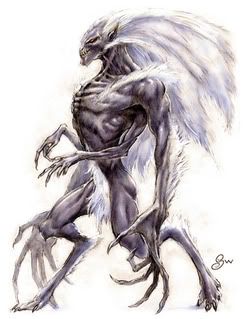Naturally some folk consider this beast to have sprung from the mind of horror writer, Algernon Blackwood, in his tale The Wendigo because humans will always try to rationalise the mysterious. But to the native tribes, the spirit was very real.

An artists impression of the Wendigo
Basil Johnston, an Ojibwa teacher gives one description of the Wendigo:
"The Wendigo was gaunt to the point of emaciation, its desiccated skin pulled tautly over its bones. With its bones pushing out against its skin, its complexion the ash gray of death, and its eyes pushed back deep into their sockets, the Wendigo looked like a gaunt skeleton recently disinterred from the grave. What lips it had were tattered and bloody. Unclean and suffering from suppurations of the flesh, the Wendigo gave off a strange and eerie odour of decay and decomposition, of death and corruption."
However skinny the creature was, it had a voracious appetite and was constantly on the prowl for flesh to devour. Whenever it dined on an unfortunate victim, it would grow bigger (and in proportion to the meal it had just scoffed) so that the Wendigo could never be filled. The beast was simultaneously gorging itself and emaciated from starvation.
So how real were these things? Many believe the stories were created as a warning not to partake in cannibalism, while others think it was sightings of mysterious Yeti~like creatures that fuelled the legend. It can never be known for certain but settlers in the regions where the stories were rife definately took the Wendigo to their frightened hearts and not in a soothing way.
It allegedly made a number of appearances near a village in Northern Minnesota from the late 1800's until the 1920's and every time it was reported, an unexpected death followed until finally it disappeared, never to be seen again.
And this is exactly how I prefer such myrhs and legends to end. 'Never to be seen again', which implies it is still out there somewhere, biding its time in some dark cave before emerging to strike terror again.

No comments:
Post a Comment